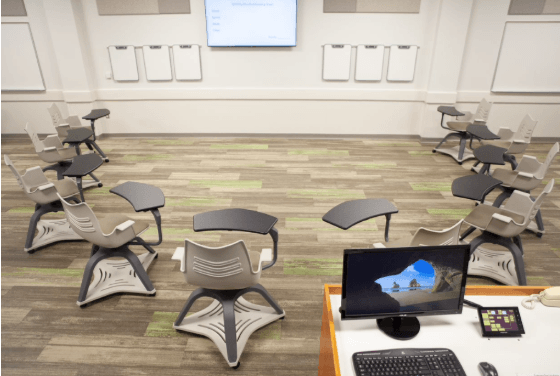Cooperative Learning Guide
Collaborative learning relies on peer-based methods to develop higher-order thinking, increase equity and accountability, decrease retention, reduce isolation, and provide exposure to diverse viewpoints. Within the cooperative learning model, the instructor becomes the facilitator who assigns group projects, monitors progress, and allows students to take ownership of their learning. A collaborative learning space can be constructed in any traditional classroom with re-arranged seating. However, at present, a cooperative learning classroom has been constructed in Health Professions 2261.

Features of the cooperative learning classroom include:
- 1149 square footage
- Rolling chairs with moveable desks/tray
- Four (4) 65"-inch LCD monitors
- 12 mobile whiteboards

To prepare to teach a cooperative learning classroom, it is best to start with the learning objectives. What goals do you want to achieve? What do you want learners to achieve? Ensure outcomes include an introduction, reinforcement, and assessment across
time to build toward larger, course-level outcomes. Next, consider students’ prior knowledge. Specifically, is there prerequisite knowledge/skills learners need to perform successfully? Lastly, to gain the most of a cooperative learning space,
consider what peer-based methods will contribute to acquiring the learning objectives. Several methods lend to a collaborative setting:
“Buzz” Groups. A large group of learners is subdivided into smaller groups of 4–5 learners to consider the issues surrounding a problem. After about 20 minutes of discussion, one member of each sub-group presents the findings of the
sub-group to the whole group.
Solution and Critic Groups. One sub-group is assigned a discussion topic, and the other groups constitute ‘critics’ who observe, offer comments, and evaluate the sub-group’s presentation.

Teach-Write-Discuss. At the end of a unit of instruction, learners must answer short questions and justify their answers. After working on the questions individually, learners compare their answers with each other. A whole-class discussion subsequently
ensues examining the array of answers presented (Christudason, 2003, p. 1).
Case Study. Students work in groups to analyze cases linked to subject matter and tied to learning outcomes. Students share their analyses.
A cooperative learning space is designed with flexibility in mind. Therefore, be prepared to arrive to class early to move seats (or assign students to set up the classroom in advance) and have whiteboard markers on hand.
Reference
Christudason, A. (2003). Peer learning. Successful Learning, 27.